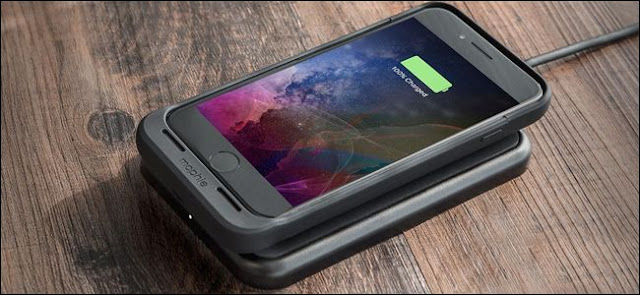Even though fewer phones support it out of the box, you do have options for adding wireless charging to your high-end phone—though admittedly, maybe not as many options as you’d like.
For a few years, every single high-end smartphone (with one notable, iPhone-shaped exception) came with wireless charging included. That seems to have changed. The 2016 flagship phones from Google, HTC, Motorola, Lenovo, Sony, and even the fan-favorite OnePlus lack both Qi and PMA charging. It seems Samsung is the only major player still interested in the feature.
Wireless Charging Phone Cases
When wireless charging first started appearing on phones running Android and other operating systems, iPhone fans were understandably miffed that their top-of-the-line gadgets didn’t have the option. Third parties rushed to fill the consumer void, and the answer they came up with was a phone case that combined basic protection with a wireless charging induction coil and an integrated charging port attachment. Voila—wireless charging for iPhones.
Mophie is probably the best known of these gadgets, offering its Charge Force cases ($60 for iPhone 7 and 7 Plus) and Juice Pack Air with an integrated external battery ($100, iPhone 7 and 7 Plus). That doesn’t include a charging pad, but the company’s technology supports both Qi and PMA standards. It sells wireless cases for the Samsung Galaxy series too, but since those phones already support wireless charging, they only come with the external battery option. Mophie doesn’t support any other phone brands.
Mophie is pretty much the only game in town when it comes to major vendors. The big drawbacks to this approach are a high price tag and a bulky design. And, you might be able to find a much cheaper wireless charging case—for a much wider variety of smartphones—by searching at your favorite online vendor.
Stick-On Wireless Charging Adapters
Stick-on adapters offer a more universal solution. If your phone doesn’t have the circular RF induction coil that’s the core of any wireless charging device, just add one on. Fed up with trying to match the ever-growing variety of phone designs with custom-fit cases, accessory providers have trimmed the fat and simply wrapped an induction coil in a plastic protective case, stuck on some glue, and added a USB charging port. It’s a flexible solution that needs only a few basic models to cover almost any phone.
The advantage to stick-on adapters is availability. Match one of these external pads up to your phone’s charging port (USB-C, Apple Lightning, or MicroUSB), stick it on the back, and you’re good to go. They’re also much cheaper than wireless charging cases, and they’re generally slim enough to fit underneath the plastic of a standard, non-charging phone case. The only downside is a rather unsightly flat cable that needs to be unplugged if you want to use a conventional charging cable.
Sporting a low cost and compatibility with practically all phones and case combinations, these adapters are probably the best bet for most users.
Roll Your Own Wireless Charging With a Phone Mod
If you’re brave enough to crack open your phone case (or if it’s out of its warranty period), and you know your way around a circuit board and soldering iron, you can install a wireless charging induction cable directly into your phone’s body. This modification has been successfully added to a variety of older devices, chronicled in the nerdier corners of YouTube and XDA-Developers.
You’ll need to cannibalize a wireless conduction receiver coil from another phone, case, or adapter—a charger won’t do. You’ll then have to remove the back cover of your phone, and insert the coil and a protective layer of plastic. Then, you’ll connect it directly to the battery or solder it to the correct pin on the charging port. Close up the phone and, if you’ve done everything right, it should charge up from a compatible pad.
Needless to say, it’s extremely easy to break your phone doing this. Even if you’re technically capable, newer devices might not have any available space within the phone’s body to house the charging cable, especially since they tend to get quite warm while in use. In fact, proximity to other portions of the phone’s internals might be dangerous. We advise anyone who isn’t confident in their modification skills—and isn’t willing to lose their fancy smartphone if they mess up—to go with a standard external adapter instead.


 10:44
10:44
 Unknown
Unknown









0 comments:
Post a Comment